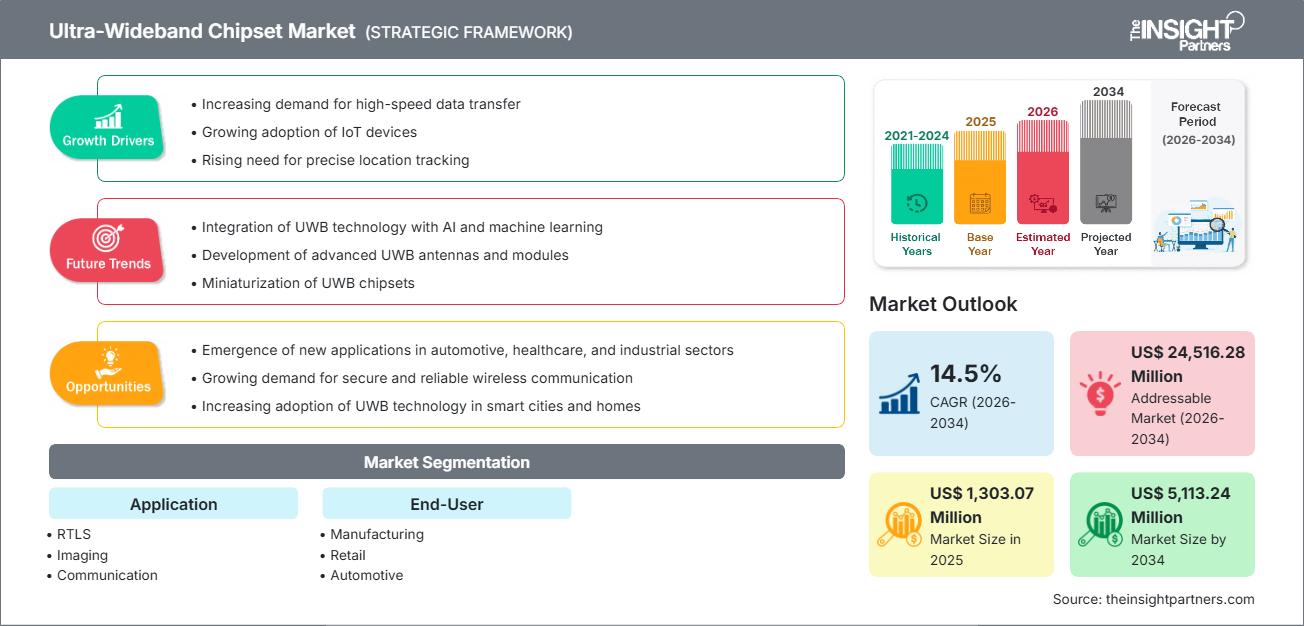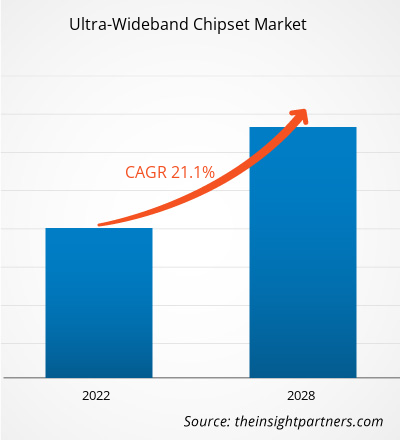Der Markt für Ultrabreitband-Chipsätze hatte im Jahr 2025 einen Wert von 1.303,07 Millionen US-Dollar und wird voraussichtlich bis 2034 auf 5.113,24 Millionen US-Dollar anwachsen, was einem durchschnittlichen jährlichen Wachstum von 14,5 % von 2026 bis 2034 entspricht.
Marktanalyse für Ultrabreitband-Chipsätze
Der Markt für Ultrabreitband-Chipsätze (UWB) wird voraussichtlich stark wachsen, aufgrund der zunehmenden Verbreitung der UWB-Technologie in Echtzeit-Ortungssystemen (RTLS), der Nachfrage nach hochpräziser Anlagenverfolgung und der Integration von UWB in Konsum- und Industriegeräte.
Die UWB-Technologie bietet im Vergleich zu herkömmlichen RTLS-Verfahren (z. B. RFID, Wi-Fi-basierte Positionierung) eine höhere Genauigkeit, eine größere Bandbreite, einen geringeren Stromverbrauch und eine bessere Störfestigkeit, was sie attraktiv macht für Anwendungen, die eine präzise Positionierung im Innen- und Außenbereich sowie eine sichere Kommunikation erfordern.
Darüber hinaus treibt das Wachstum in den Bereichen IoT, intelligente Geräte, tragbare Elektronik, Automobilanwendungen (z. B. sicherer Zugriff, Fahrzeuglokalisierung) und industrielle Automatisierung – die alle von UWB-Chipsätzen profitieren – die Nachfrage an.
Marktübersicht für Ultrabreitband-Chipsätze
Ultrabreitband-Chipsätze sind integrierte Schaltkreise, die UWB-Kommunikation ermöglichen – eine drahtlose Technologie, die ein breites Frequenzspektrum für die Datenübertragung und Entfernungsmessung über kurze Distanzen mit hoher Präzision und geringem Stromverbrauch nutzt. Diese Chipsätze sind grundlegend für präzise Echtzeit-Ortungssysteme (RTLS), sichere Zugangskontrolle, die Kommunikation zwischen Geräten und weitere Anwendungsfälle in der Unterhaltungselektronik, der Automobilindustrie, der Industrie, dem Gesundheitswesen und dem Einzelhandel.
Durch die Ermöglichung einer Lokalisierungsgenauigkeit im Zentimeterbereich, geringer Latenz, Störfestigkeit und energieeffizienter Kommunikation helfen UWB-Chipsätze Geräteherstellern und Systemintegratoren dabei, eine robuste Leistung zu erzielen, sei es für die Verfolgung von Gütern in einem Lagerhaus, die Ermöglichung der räumlichen Wahrnehmung von Smartphones oder die Bereitstellung eines sicheren schlüssellosen Zugangs in Automobilen.
Da die Nachfrage nach präziser Positionierung, Echtzeitverfolgung und sicherer Kommunikation stetig steigt, entwickeln sich UWB-Chipsätze zu einer kritischen Infrastrukturkomponente in zahlreichen Branchen.
Passen Sie diesen Bericht Ihren Anforderungen an.
Sie erhalten eine kostenlose Anpassung aller Berichte – einschließlich Teilen dieser Berichte, Länderanalysen und Excel-Datenpaketen – sowie attraktive Angebote und Rabatte für Start-ups und Universitäten.
Markt für Ultrabreitband-Chipsätze: Strategische Einblicke

-
Ermitteln Sie die wichtigsten Markttrends dieses Berichts.Diese KOSTENLOSE Probe beinhaltet eine Datenanalyse, die von Markttrends bis hin zu Schätzungen und Prognosen reicht.
Markttreiber und Chancen für Ultrabreitband-Chipsätze
Markttreiber:
- Anforderungen an hochpräzise Ortung und Verfolgung: Die Nachfrage nach genauen Echtzeit-Ortungssystemen (RTLS) in den Bereichen Fertigung, Logistik, Einzelhandel, Gesundheitswesen und intelligente Infrastruktur nimmt zu, was die Akzeptanz von UWB gegenüber weniger genauen Alternativen fördert.
- Zunehmende Integration in Unterhaltungselektronik und intelligente Geräte: Mit der Verbreitung von Smartphones, Wearables, Smart-Home-Geräten und IoT-Geräten werden UWB-Chipsätze immer häufiger integriert, um räumliches Bewusstsein, sichere Kommunikation und standortbasierte Funktionen zu ermöglichen.
- Zunehmende Anwendungen im Automobilbereich: UWB wird für sichere Fahrzeugzugangs-, Lokalisierungs- und Kommunikationsfunktionen genutzt, was zu einer erhöhten Nachfrage nach Chipsätzen seitens der Automobilhersteller beiträgt.
- Nachfrage nach energiearmer, störungsresistenter Kommunikation: Die inhärenten Vorteile von UWB, geringe Latenz, Robustheit gegenüber Mehrwegeausbreitung/Interferenzen und Energieeffizienz machen es geeignet für moderne drahtlose Systeme, die Zuverlässigkeit und Präzision erfordern.
Marktchancen:
- Branchenübergreifende Expansion und neue technologische Anwendungsfälle: Angesichts der wachsenden Nachfrage in den Bereichen Logistik, intelligente Fertigung, Anlagenverfolgung im Gesundheitswesen, Bestandsmanagement im Einzelhandel und Smart-Home-/Smart-Office-Automatisierung wird mit einer breiteren Akzeptanz von UWB-Chipsätzen gerechnet.
- Verbreitung von IoT und intelligenten Geräten: Da sich IoT-Ökosysteme weltweit ausbreiten, bietet die Integration von UWB-Chipsätzen in immer mehr Geräte ein beträchtliches Wachstumspotenzial, unter anderem bei Wearables, Smart Tags und der Kommunikation zwischen Geräten.
- Innovationen im Automobil- und Mobilitätsbereich: Der Einsatz von UWB in den Bereichen Fahrzeugzugang, sichere Kommunikation und Lokalisierung eröffnet große Chancen für Chiphersteller, die mit Automobilherstellern zusammenarbeiten.
- Migration von veralteten Tracking-/Kommunikationstechnologien: Da Unternehmen und Verbraucher eine höhere Genauigkeit und Sicherheit fordern, präsentiert sich UWB als Ersatz für ältere Systeme (z. B. RFID, einfaches Bluetooth) und treibt so die Verbreitung von Chipsätzen voran.
Marktsegmentierungsanalyse für Ultrabreitband-Chipsätze
Auf Antrag:
- Echtzeit-Ortungssysteme (RTLS)
- Bildgebung
- Kommunikation
Nach Endnutzer / Branche:
- Herstellung
- Einzelhandel
- Automobil
- Gesundheitspflege
- Unterhaltungselektronik
Nach Geographie:
- Nordamerika
- Europa
- Asien-Pazifik
- Süd- und Mittelamerika
- Naher Osten und Afrika
Regionale Einblicke in den Markt für Ultrabreitband-Chipsätze
Die regionalen Trends und Einflussfaktoren auf den Markt für Ultrabreitband-Chipsätze im Prognosezeitraum wurden von den Analysten von The Insight Partners eingehend erläutert. Dieser Abschnitt behandelt außerdem die Marktsegmente und die geografische Verteilung des Ultrabreitband-Chipsatzmarktes in Nordamerika, Europa, Asien-Pazifik, dem Nahen Osten und Afrika sowie Süd- und Mittelamerika.
Berichtsumfang zum Markt für Ultrabreitband-Chipsätze
| Berichtattribute | Details |
|---|---|
| Marktgröße im Jahr 2025 | 1.303,07 Millionen US-Dollar |
| Marktgröße bis 2034 | 5.113,24 Millionen US-Dollar |
| Globale durchschnittliche jährliche Wachstumsrate (2026 - 2034) | 14,5 % |
| Historische Daten | 2021-2024 |
| Prognosezeitraum | 2026–2034 |
| Abgedeckte Segmente |
Durch Bewerbung
|
| Abgedeckte Regionen und Länder |
Nordamerika
|
| Marktführer und wichtige Unternehmensprofile |
|
Marktdichte von Ultrabreitband-Chipsätzen: Auswirkungen auf die Geschäftsdynamik verstehen
Der Markt für Ultrabreitband-Chipsätze wächst rasant, angetrieben durch die steigende Nachfrage der Endnutzer. Gründe hierfür sind unter anderem sich wandelnde Verbraucherpräferenzen, technologische Fortschritte und ein wachsendes Bewusstsein für die Vorteile des Produkts. Mit steigender Nachfrage erweitern Unternehmen ihr Angebot, entwickeln innovative Lösungen, um den Kundenbedürfnissen gerecht zu werden, und nutzen neue Trends, was das Marktwachstum zusätzlich beflügelt.

- Verschaffen Sie sich einen Überblick über die wichtigsten Akteure auf dem Markt für Ultrabreitband-Chipsätze.
Marktanteilsanalyse für Ultrabreitband-Chipsätze nach Regionen
Laut einem Bericht von The Insight Partners umfasste die regionale Präsenz des Marktes im Jahr 2021 Nordamerika, Europa, den asiatisch-pazifischen Raum, Lateinamerika, den Nahen Osten und Afrika.
Historisch gesehen hatte der asiatisch-pazifische Raum einen bedeutenden Umsatzanteil (führend unter den Regionen), gefolgt von Nordamerika und Europa.
Das Wachstum dürfte regional unterschiedlich ausfallen, abhängig von der Technologieakzeptanz, der Industrialisierung, der Verbreitung von Unterhaltungselektronik, der Integration in die Automobilindustrie und der Entwicklung der IoT-Infrastruktur. Besonders im asiatisch-pazifischen Raum und in Schwellenländern besteht ein großes Potenzial.
Wettbewerbsumfeld & Spielerdichte
Der Markt für Ultrabreitband-Chipsätze ist durch das Vorhandensein zahlreicher globaler Akteure und spezialisierter Chiphersteller gekennzeichnet. Diese Anbieter differenzieren sich durch:
- Integration von UWB-Chipsätzen in vielseitige ICs für Konsumgeräte und IoT.
- Fortschrittliches Chipset-Design zur Optimierung von Leistung, Bandbreite und Störfestigkeit.
- Strategische Kooperationen mit Geräteherstellern (Smartphones, Automobil-OEMs, Hersteller von Industrieanlagen) zur Integration von UWB in Produkte der nächsten Generation.
- Innovation mit dem Ziel, UWB für RTLS-, Kommunikations- und Bildgebungsanwendungen in verschiedenen Branchen anzupassen.
Wichtige Unternehmen, die auf dem Markt für Ultrabreitband-Chipsätze tätig sind
- ALEREON, Inc.
- Apple Inc.
- Bespoon SAS
- Decawave Limited
- TAIYO YUDEN CO., LTD.
- Johanson Technology, Inc.
- NOVELDA AS
- NXP Semiconductors NV
- Pulse-Link, Inc.
Weitere im Rahmen der Untersuchung analysierte Akteure sind:
- Texas Instruments Incorporated
- STMicroelectronics NV
- Samsung Electronics Co., Ltd.
- Zebra Technologies Corporation
- Sony Corporation
- Infineon Technologies AG
- Murata Manufacturing Co., Ltd.
- LitePoint Corporation
- Sewio Networks sro
- Nanotron Technologies GmbH
Neuigkeiten und aktuelle Entwicklungen auf dem Markt für Ultrabreitband-Chipsätze
- Der globale Bericht von The Insight Partners bestätigt das starke Wachstum: Der Markt für UWB-Chipsätze soll bis 2028 ein Volumen von 1.906,46 Millionen US-Dollar erreichen.
- Der zunehmende Einsatz von UWB in RTLS, Endgeräten und der Automobilindustrie wird als wichtiger Wachstumstreiber identifiziert, da UWB eine höhere Genauigkeit aufweist und in der Lage ist, veraltete Ortungs-/Kommunikationssysteme zu ersetzen.
Marktbericht zu Ultrabreitband-Chipsätzen: Abdeckung und Ergebnisse
Der Bericht „Ultra-Wideband Chipset Market Size and Forecast (2021–2034)“ von The Insight Partners bietet Folgendes:
- Detaillierte Marktgrößen- und Prognoseanalyse auf globaler, regionaler und Länderebene für wichtige Segmente.
- Analysieren Sie von Markttrends, Wachstumstreibern, Chancen und der zugrunde liegenden Marktdynamik.
- Segmentierung nach Anwendung, Endnutzer und Geografie.
- Wettbewerbsumfeld und Unternehmensprofile führender Chiphersteller.
- Historische Analyse (2 Jahre), Basisjahr, Prognose (7 Jahre) mit CAGR
- PEST- und SWOT-Analyse
- Marktgröße Wert/Volumen – Global, Regional, Land
- Branchen- und Wettbewerbslandschaft
- Excel-Datensatz
Aktuelle Berichte
Erfahrungsberichte
Grund zum Kauf
- Fundierte Entscheidungsfindung
- Marktdynamik verstehen
- Wettbewerbsanalyse
- Kundeneinblicke
- Marktprognosen
- Risikominimierung
- Strategische Planung
- Investitionsbegründung
- Identifizierung neuer Märkte
- Verbesserung von Marketingstrategien
- Steigerung der Betriebseffizienz
- Anpassung an regulatorische Trends






















 Kostenlose Probe anfordern für - Markt für Ultrabreitband-Chipsätze
Kostenlose Probe anfordern für - Markt für Ultrabreitband-Chipsätze